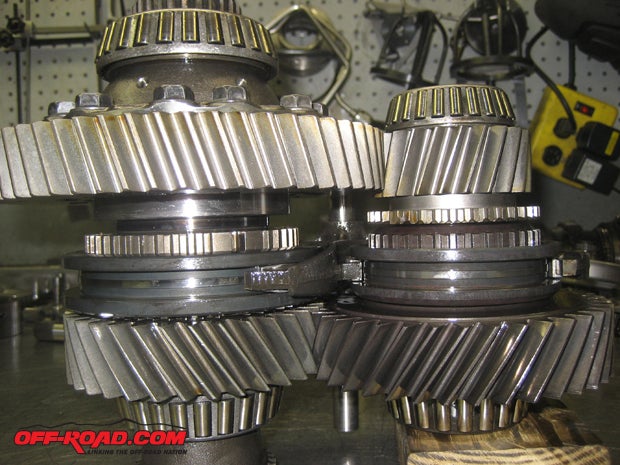
Is there a 4x4 that begs larger tires more than the venerable 80 Series Land Cruiser? Its wheel wells engulf tires. A 33-inch tire fits with no lift. True 35s only need 3 inches of added suspension. Many serious 80 enthusiasts soon ponder ‘why not 37’s?’ The massive axles hold up to the added strain, and then some. In the frozen mess called Iceland, the 80 Series is routinely outfitted with 44-inch tires to cross miles of snow and ice.
Simply put, an 80 Series on stock 4.11 gears and no lift is darn impressive. If it’s factory locked in both axles in addition to the stock center diff lock, the 80 Series will claw its way up, over and through some gnarly obstacles. Add that modest lift and larger tires and the truck is more capable than many a heavily modified Jeep. Its point-n-shoot capabilities mean you can clean tough obstacles in comfort, with the automatic transmission handling touchy starts and snail’s-pace crawling. Leather seats, cold A/C and seats for seven mean it’s a posh ride for friends and family as well.
But for all of these rare qualities, Toyota’s overbuilt 5,000-pound truck—the last with a solid front axle—has an Achilles heel: gearing. This weak point highlights the dilemma of the beefiest 4x4 Toyota has ever produced: big tires are easy to add, but they only heighten the need for better gearing.
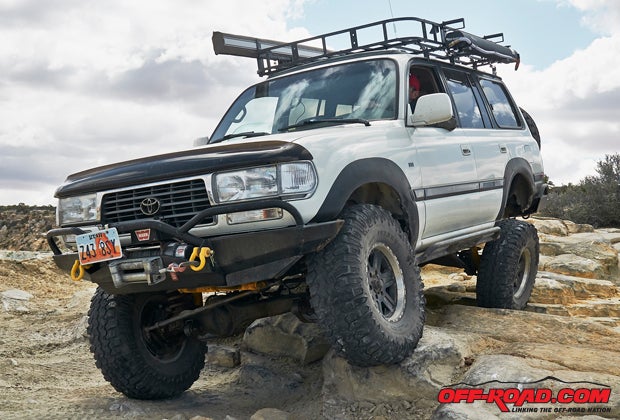
Don’t get me wrong, owners of the 1990 to 1997 80 Series have long appreciated the highway-friendly factory gearing of their rigs. But with larger tires come an incremental need for differential gear changes. A set of 4.56 or, more likely, 4.88 ring and pinion gears are helpful to get back to factory gear ratios for highway driving. And 5.29s are ideal to allow the 37-inch (or larger) tires that those giant wheel wells will accept. But when the terrain calls for 4Lo, the modest 2.488:1 factory crawl ratio provided by Toyota’s transfer case still falls short of what’s needed. For the average owner, who’s not spent the $1400-2000 to re-gear the differentials, the lack of low range is even more acute after larger tires are swapped on.
That’s the situation we faced with our 1997 Limited Edition FZJ80. It was riding high on 6” of Christo Slee’s best suspension lift, shod with 35” TrXus MTs. That combination provided a terrific ride. It’s smooth, offers good clearance, and rolls over obstacles fairly well – until things get steep, that is. On the inclines that mark our favorite destination, southern Utah’s slick rock country, too much skinny pedal was needed to get through classic obstacles like High Dive (Behind the Rocks) and Tip-over Challenge (Hell’s Revenge). Historically, there was only one solution: import Mark’s Crawler Box from Australia, and start the custom modifications (e.g., gas tank relocation).
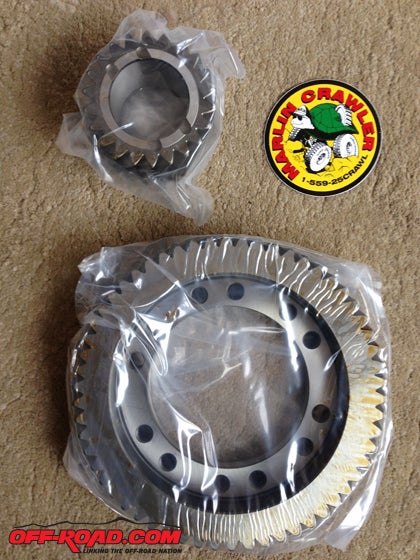
All that changed in late 2012 when Marlin Crawler brought a game changer to the market. Marlin is the undisputed pioneer of crawling. But for years the plight of the portly, under-geared FJ/FZJ80 had gone unresolved. Marlin Czajkowski, along with son Michael (a.k.a., “Big Mike“) and his team, applied the company’s renown gearing expertise to the heftiest of the Cruisers. Made famous by crazy-low dual transfer case setups and Toyota mini-trucks that move about as fast as a desert tortoise, Marlin & Co. began turning their attention to the 80 Series in 2011. After exploring the workings and clearances in the truck’s transfer case, they designed a replacement gear set, and continued their past relationship with Toyota’s own gear cutter in Japan to produce the prototype. The result is the long-anticipated 80/100 Series Crawler Gears.
Replicating the Install
Having read about the new Crawler Gears, I immediately reached out to Marlin Crawler to do a product review. By early March a box had arrived, and I was off to the races. Big Mike and the guys intended that the install be very feasible for an owner to do. They’ve provided a very thorough explanation of the Crawler Gears’ installation on their website, describing it in illustrated, step-by-step detail. While owners can follow their very thorough instructions [http://board.marlincrawler.com/index.php?topic=88536 ], my own interest was in seeing how the instructions would work for guiding an experienced transmission mechanic.
To find out, I took the truck to OneWay Transmissions in Logan, UT. Owner Frederick Osmus is a seasoned veteran, having begun his career in 1986, earning his ASE certification in California, and later working for AAMCO before opening his own shop a decade ago. Averaging two transmissions a day, he’s seen quite a few gear sets, and is himself a Land Cruiser owner. He’s also an ATRA (Automotive Transmission Repair Assoc.) member, and has authored Tech Service Bulletins nationally.
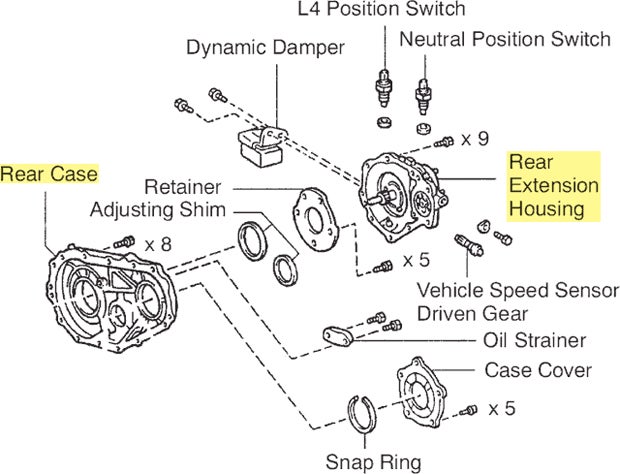
The challenge I put before Fred was basically this: hand him the keys, the box of gears, and a print-out of Marlin’s online instructions and say, “Make it happen. Then tell me what you’d do differently, and what’s missing.” Fred personally completed all the work, and we routinely discussed progress, steps, and his observations. Along the way he photographed the process, and I interviewed him about lessons learned. What we learned is encapsulated in these take-homes:
- Marlin’s write-up was “beautifully done, and very thorough.” Fred followed the steps just as described.
- Fred’s bench time for the gear set was 3-3.5 hours. Total shop time was estimated at 6 hours.
- Doing the install in the vehicle equates to a two-person job for different steps.
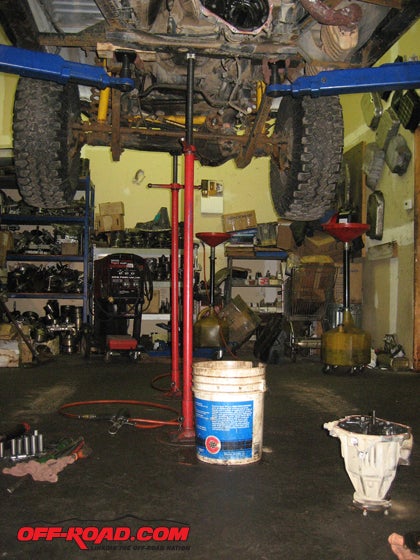
- Perhaps the most problematic aspect of an in-vehicle installation is the shift/fork alignment, as the fork’s notch must be carefully positioned while holding up the 50-pound gear set. Even with two sets of hands, this was cumbersome for Fred and an experienced coworker.
- Working on a bench allowed gravity to be used to aid with critical alignments and reassembly. It also reduced chances for mistakes related to visibility.
- An air cut-off tool with a 2-inch wheel was used for trimming of the metal shield. This was an apparent omission from Marlin’s original instructions. The step necessitated thorough cleaning out the resulting filings/metal dust.
- OEM Toyota silicone sealant was used for resealing the case ($20): P/N 00295-01281.
- At 500 miles the oil was swapped out for a full synthetic Schaeffer product.
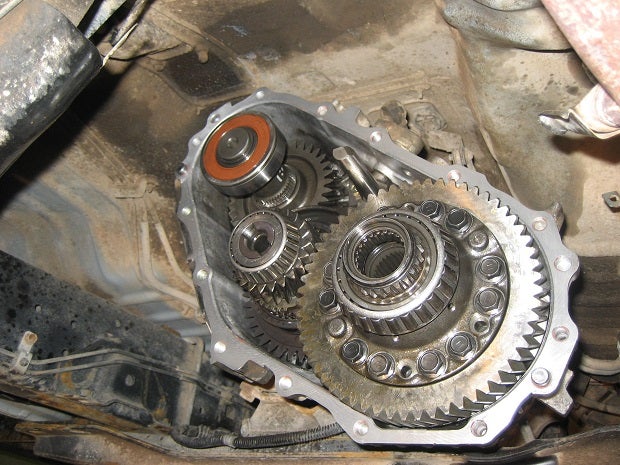
Summary:
In hindsight, Fred concluded that a person should definitely do the entire install on the bench. That is, they should pull the entire t-case out. This approach would be as fast as working on the unit in the truck, but far easier when it comes to alignments, cleaning, and seeing what you’re doing. Reassembly on the bench also permits more careful cleaning and prep of mating surfaces for sealant application.
One of the additional needs that arose during the installation was for a new front drive shaft and seals. These were problems unrelated to the Crawler Gears, but were tied to the 150,000+ miles on the Land Cruiser along with the impacts of the Slee lift kit. As with any significant install, it’s the perfect time to address any maintenance items.
Performance
Following the 500-mile wear in and oil change, the real fun began. The 80 was driven over trail sections, obstacles, and through a series of urban routes that had been previously timed for marked distances. We also tracked engine speeds to gauge changes. The results were immediately apparent. The Crawler Gears are described by Marlin as producing a 25% improvement in low-range speeds. All of our timed course driving verified that as we held the rpm at a fixed speed over the fixed courses. This was a noticeable improvement and gave that sense of ‘this is taking forever’ to crawl the 300-yard distance.
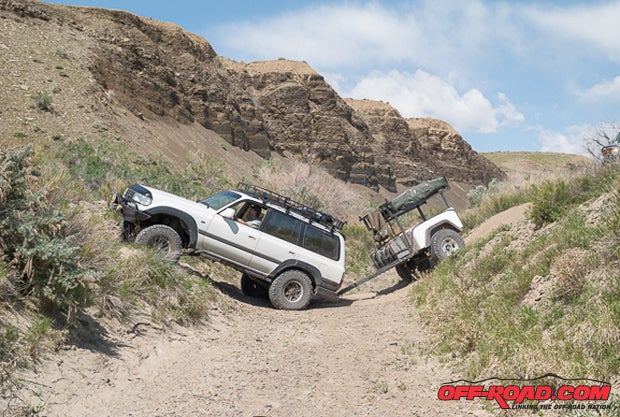
As much as we think about low-range gears helping to crawl, there’s an often forgotten perk. Engine braking, though often overlooked, is the second off-road benefit of lowered gear ratios. To give a controlled real-world test, I conducted a coasting run in 4Lo, Lo gear. The process was repeated on consecutively steeper city streets to emulate trail descents. The first course, an 11% grade, could only increase the truck’s RPM to 1000. The next, averaging 13%, spun the motor up to 1075 RPM before the speed stabilized. Finally, a steep 15% hill was descended. That slope brought the RPM up to 1100 but also managed to plateau acceleration. These impressive figures really illustrated the benefit of the Crawler Gears when it comes to downhill control of an armored 80, which weights 6,000 pounds with a driver on board. Over the next year, I would later feel how this helped control descents when heavily laden.
Since the install, I’ve enjoyed a year of wheeling through the Intermountain West. The subtle change I’d become familiar with when dropping into Lo range was replaced by the new, substantially slower pace of the Crawler Gears. The change is a definite improvement. When it’s time for Lo range, I want to gain control, torque and time to ease through obstacles. As an automatic, the 80 Series wouldn’t respond the same way that a five-speed does if a super low Lo range is installed. You simply can’t choose which gear to begin in, and thus a set of really low transfer case gears would make the step down from Hi range too great. Could the Crawler Gears be lower? Yes and no. Yes, I could see having them be closer to a 33% reduction. In fact, with the torque converter, the gain is nearly 75% lower. But, no, they can’t be made lower. Why? Big Mike pointed out that while the Toyota case has a bit more clearance for lower gears, the trade off would be making each tooth thinner. Thus they utilized every possible millimeter of room to make the gears as slow as possible without negatively impacting the gears’ strength.
So how is it? In my experience, the change is a welcome and much needed improvement. The acid test for me was wheeling not just 6+ trails of Moab and the Canyonlands area, but towing the new Dinoot offroad trailer through those trails. Wheeling with a trailer tests not only the driver, but also the tow vehicle. Wheel placement must be more precise. Momentum has to be administered precisely. Ascents require greater control to avoid spinning rubber due to the added tug of 700 pounds or more of a rolling anchor. And, I quickly found, descents with a trailer beg lowered gearing to help resist the constant ass-end push that wants to send you over drops too fast.
The Kokopelli Trail made a true believer out of me when it comes to these gears. The 100-mile route traverses the Colorado-Utah line, crisscrossing sand washes, slickrock, a river crossing, and myriad boulder obstacles. The range of terrain was perfect for testing day after day how the Crawler Gears helped the big Toyota negotiate the route. With several other 80s on this Cruise Moab event, along with an FJ Cruiser, 100 Series and 4Runner also towing trailers, the gearing was easy to compare to others driver’s setups. The difference was nowhere more evident than pulling the trailer up to the Top-of-the-World overlook. While all other trailers were left in camp, this was the test I was waiting for. From 3-foot ledges to continual scree and boulders, this looping trail highlighted why these gears were long overdue.
In addition to exploring the red rock country of southern Utah, both with and without the Dinoot trailer, we’ve used the Land Cruiser Crawler Gears in a mix of other situations. One that stands out was another trailer towing challenge. We annually haul a full cord of hardwood logs into a mountain getaway, stocking up the firewood supply before snow flies. The trail in is a mix of rock gardens, high meadows with grasses above the hood, and off-camber slopes. Towing a military M101 trailer with firewood piled above the stake sides up that mountain was far easier and more in control than in the past. Marlin’s gears add that extra margin of grunt.
Conclusion
Some have said that Toyota made the 80 Series too cumbersome—too fat, really—for serious wheeling. While undoubtedly one of the best overland/expedition vehicles ever, the truck’s mass is said to be too unwieldy. I beg to differ. Unless Pritchett Canyon or similar buggy territory is where you’re heading, the biggest Land Cruiser ever is a great platform to wheel hard. Marlin Crawler has made wheeling the 80 and the 100—both of which share the same transfer case gears—that much easier, extending the crawl ratio into new territory. Will it mean you can literally drive your 80 into new terrain? Probably not. But it is going to mean you’re driving the hardest trail sections in greater control, and with less risk of breakage. For around half the price of a differential gear swap, that’s a welcome change. My hat’s off to the men behind the turtle for making this possible.
SOURCES
Marlin Crawler, Inc.
1543 N. Maple Ave
Fresno, CA 93703
(888) 94-CRAWL (942-7295)
http://www.marlincrawler.com/
OneWay Transmission
2300 N Main St # G,
Logan, UT 84341
(435) 750-6080


 Your Privacy Choices
Your Privacy Choices